Building a robust cloud ecosystem
From cloud marketplaces to app stores to integration networks, the ecosystem play is a powerful lever to develop and cement market leadership.
One of the tried and true strategies we’ve witnessed that rapidly scales a cloud business and helps fuel its hyper-growth to $1 billion ARR is building out a robust ecosystem. From cloud marketplaces and app stores to integration networks, the ecosystem play is a powerful lever for companies to accelerate through the $100 million ARR mark.
Capitalizing on this next “Act” to develop an ecosystem is effective for companies at this stage since they have already attained a base level of market awareness leading to other third-party partners want to work with them. Building a partner ecosystem creates infrastructure that further reinforces market dominance — companies that get the ecosystem play right assert themselves as integral to a given technology stack, and they benefit from ongoing customer leads brought in via product extensions.
This cloud business lesson has come to life time and time again — so much so that the top ten companies on the BVP Cloud Index by market capitalization have all implemented this ecosystem strategy.
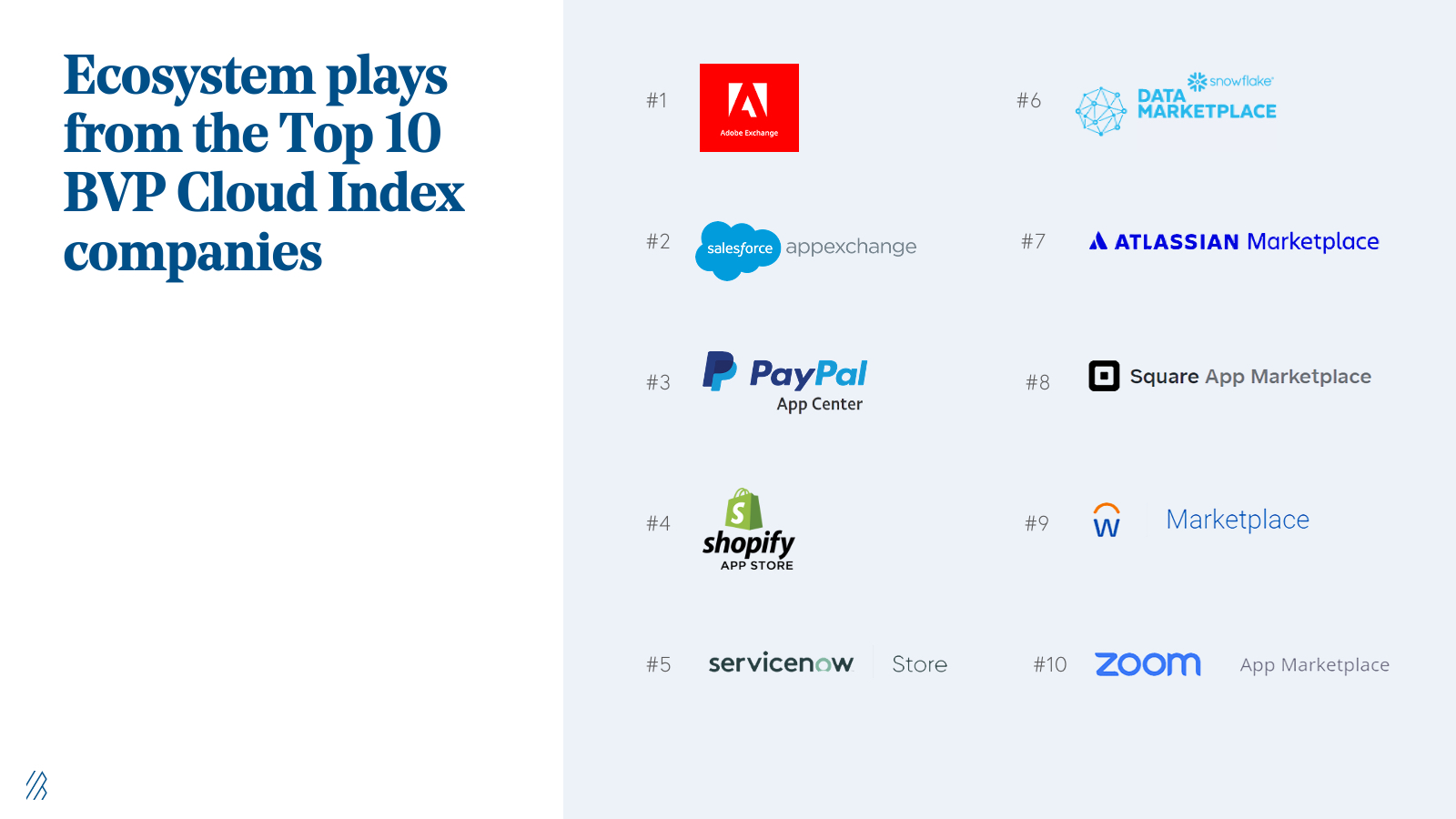
As you think about building the next enduring market leader, here are seven lessons from cloud giants, including DocuSign, Okta, Salesforce, Shopify, and Twilio, on how to build a strong ecosystem that can serve as a moat of defensibility against competitors while unlocking unprecedented scale for your company.
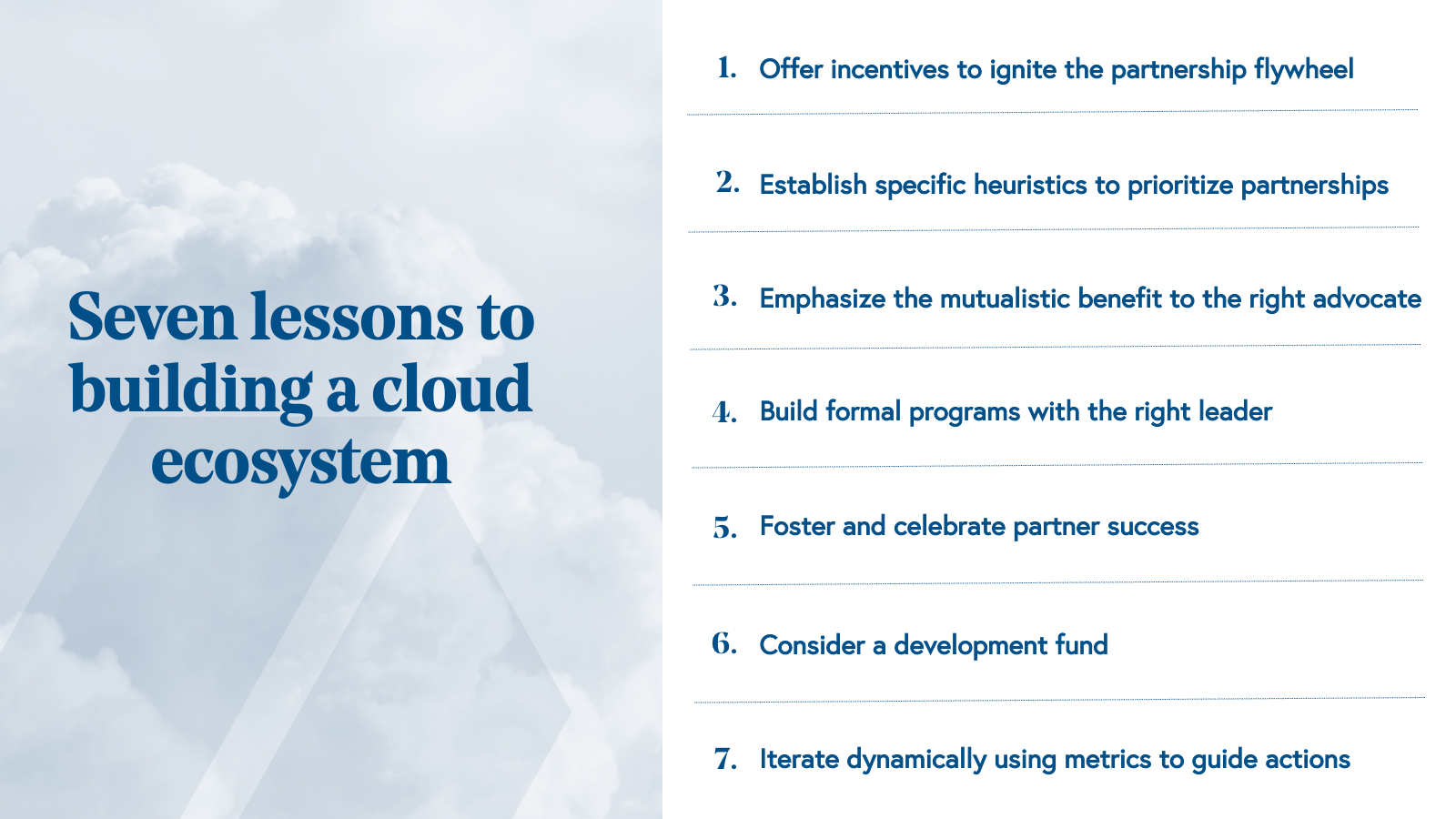
1. Offer incentives to ignite the partnership flywheel
In the very early days of your ecosystem journey, simply “pitching” partners to develop integrations may not be enough to spark action, especially when no precedent or track record has been established. You may need to offer tangible rewards, such as monetary incentives, to potential partners in order to spark your ecosystem flywheel initially.
Incentivizing partners was the philosophy Shopify adopted when they launched their App Store in 2009. Shopify had two goals–extending the functionality of Shopify’s platform through app development from independent parties and growing Shopify’s merchant base through partner referrals. In the early days, the program was treated almost akin to a “cost center,” offering prizes and monetary support to their inaugural batch of developers to get the flywheel sparked.
Shopify’s strategy worked to resounding success. In less than five years, Shopify had onboarded over 500 partners. Today, there are over 6,000 publicly available apps across Shopify’s App Store. Eighty-five percent of Shopify merchants rely on at least one App Store solution to run their business, with an average usage of six apps per merchant. Additionally, the number of partners who referred at least one new merchant to Shopify has also been increasing steadily year over year— a testament to the effectiveness of their incentive program for partner-sourced referrals.
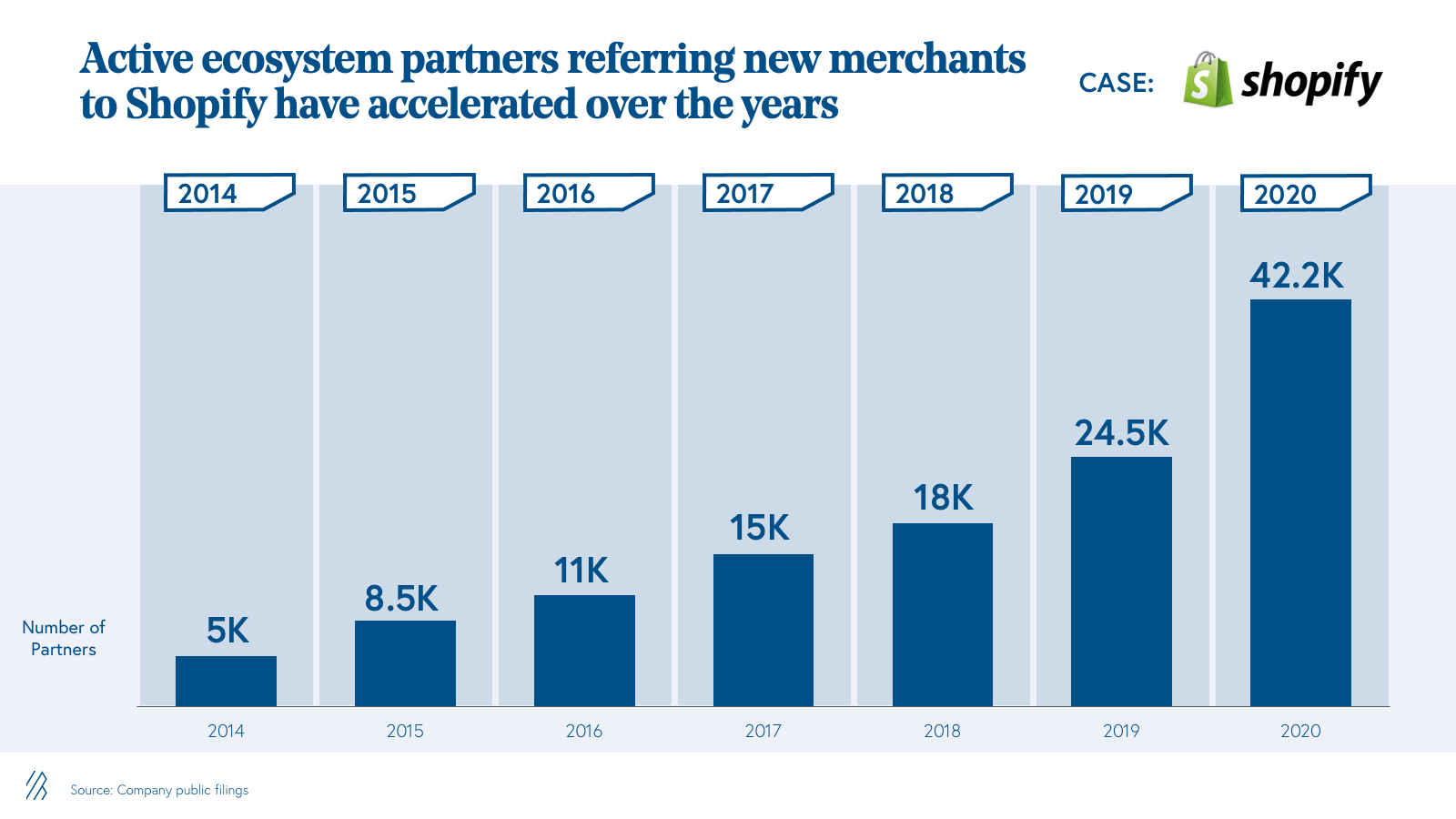
A robust partner ecosystem hasn’t just been good for Shopify. App Store partners, including developers, designers, and agencies, earned $12.5 billion in revenue in 2020, a staggering 4x increase in Shopify’s total revenue.
Even as Shopify’s ecosystem matured significantly, the company still offers one of the most generous partner referral programs in the business. Not only do partners have the ability to earn 10-20% of recurring commission in perpetuity, but in 2021, Shopify announced that it would drop all commissions on app developer revenue to 0% (previously 20%) for developers who make less than $1 million annually on Shopify’s platform.
2. Establish specific heuristics to prioritize partnerships
When you first begin building out your ecosystem, it's easy to be pulled in many different directions by the overwhelming number of potential engagement partners. Having some simple structure around which partnership opportunities to prioritize is critical to stay focused on the direction of the business.
To reach ecosystem-scale without falling off course, identity and access management market leader Okta uses a predefined set of heuristics when assessing new business relationships. The company uses a matrix scoring framework to prioritize potential partners, in which they consider several main factors including enterprise readiness, buying center affinity, and alignment with Okta’s core values such as customer-centricity and constant innovation.
Prioritization is also tactical and influenced by Okta’s overarching product vision, taking into account specific use cases they want to extend through partnerships in order to amplify value to the end customer. The company’s initial partnership strategy focused on a core set of enterprise vendors they commonly ran into and began with email as an initial focus. Today, Okta has 7,000+ pre-built integrations and 1,400+ SAML and OIDC integrations—one of the industry’s most extensive and most comprehensive partner catalogs.
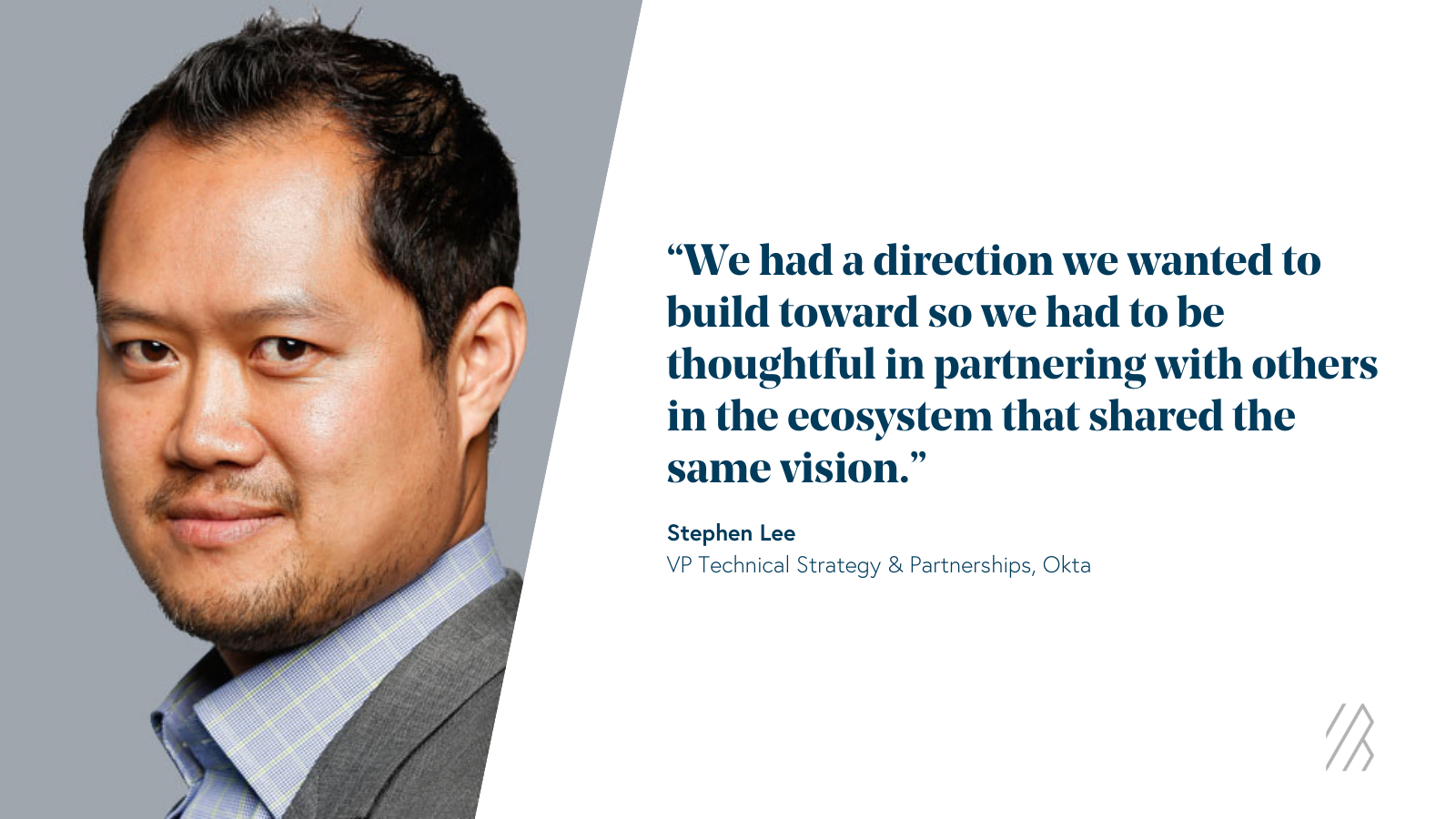
3. Emphasize the mutualistic benefit to the right advocate
Mutualistic relationships—the ecological interaction between two or more species with a net benefit—are integral to thriving ecosystems in nature. This dynamic applies equally to the cloud world. The best ecosystem creators use this core “win-win” philosophy to guide their actions. Instead of extracting maximum value from partners, they are committed to everyone’s success to expand the total pie for all.
Okta grasped this concept well and knew that an empathic approach to building the ecosystem would be more effective than trying to “brute force” unnatural partnerships. It had to clearly propose the mutual benefit for partners to be motivated to work with Okta -- including stakeholders outside of the C-suite. As they assessed potential targets, Okta identified stakeholders across the entire organization hierarchy that would benefit the most from new opportunities and solutions that Okta could help unlock. Then the company created a detailed playbook to address these potential champions, which included specific bullet points to cover in every value-add conversation, highlighting how both Okta and the partner could succeed together.
Crucially, these benefits would differ depending on the audience. Rather than using a one size fits all strategy, Okta dug deep into the precise pain points Okta could help resolve for specific stakeholders to drive home the potential for a mutualistic relationship. For specific sales leaders, Okta focused on how a partnership would unlock the enterprise segment, while conversations with product managers often concentrated on how Okta could facilitate product adoption. Okta even identified companies facing similar headwinds or competition as Okta articulated how joining forces could make both parties more resilient.
While your playbook will be iterative and content will improve with more conversations, a good first step is actively understanding potential partners’ needs and conveying the high-level mutual benefits that your technology can provide to your target partner set.
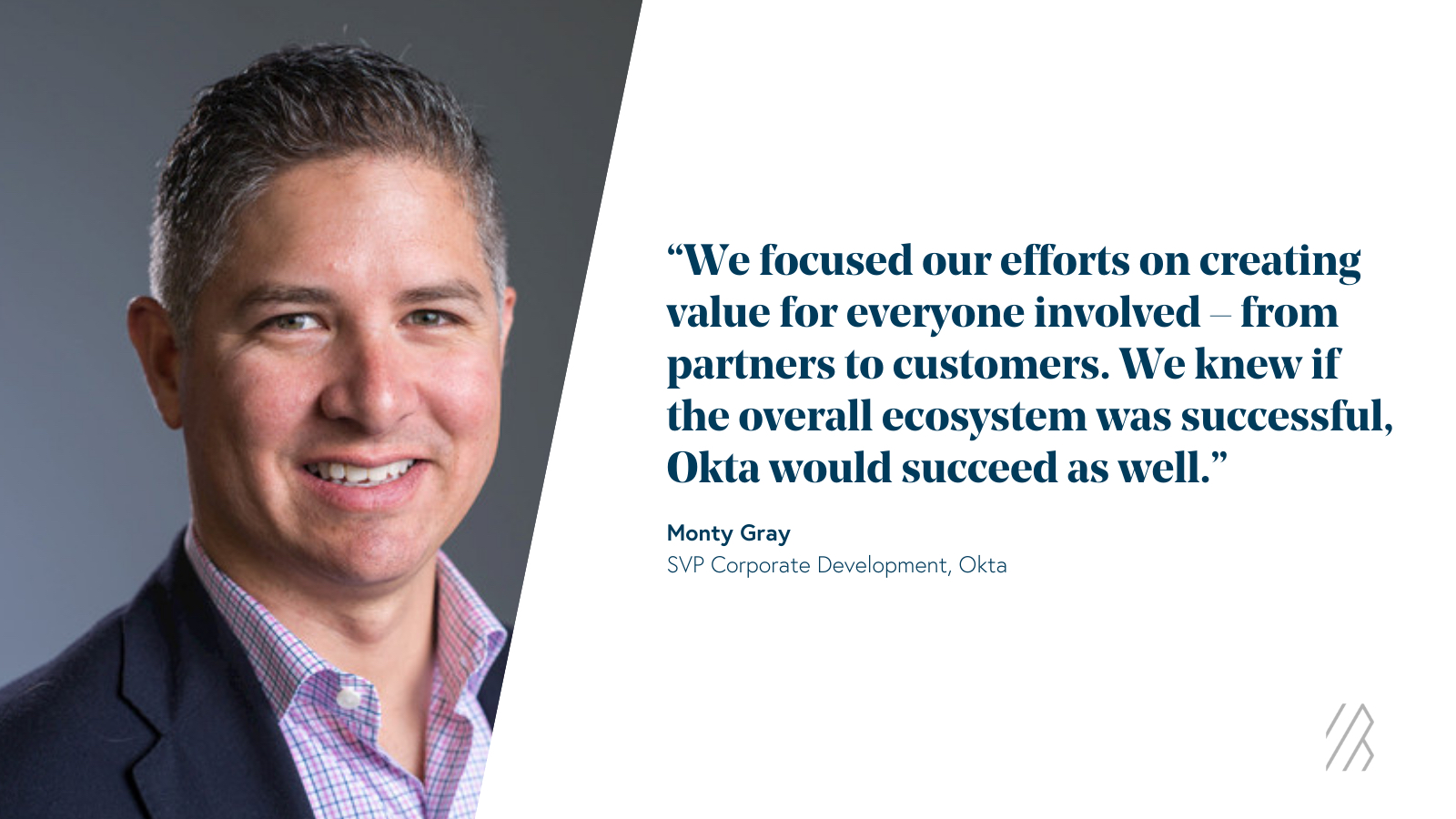
4. Build formal programs with the right leader at the helm
Once the initial experimentation phase is over, and the team steps on the gas to run an ecosystem play, it is vital to set up a distinct team responsible for partnerships with its dedicated leader. Hiring the proper leader sets the tone for the initiative’s vision, and it can make or break your strategy.
There is no “perfect” profile as this will vary based on what the program goals are. For instance, Okta chose to go with an experienced partnerships leader with a technical background — someone who could “speak” the language of business as well as technical stakeholders — as the company knew their partnership program would involve a level of technical sophistication given the types of integrations and ideal partners they wanted to develop.
On the other hand, DocuSign did not focus on prior partnership experience, and instead prioritized a leader that had a track record of strong execution as measured by demonstrable business results. In another example, Shopify chose to go with leaders who were very invested in relationship management and had solid sales and business development mindsets since this leader would focus on building a broad, inclusive community as a foundation for their program success.
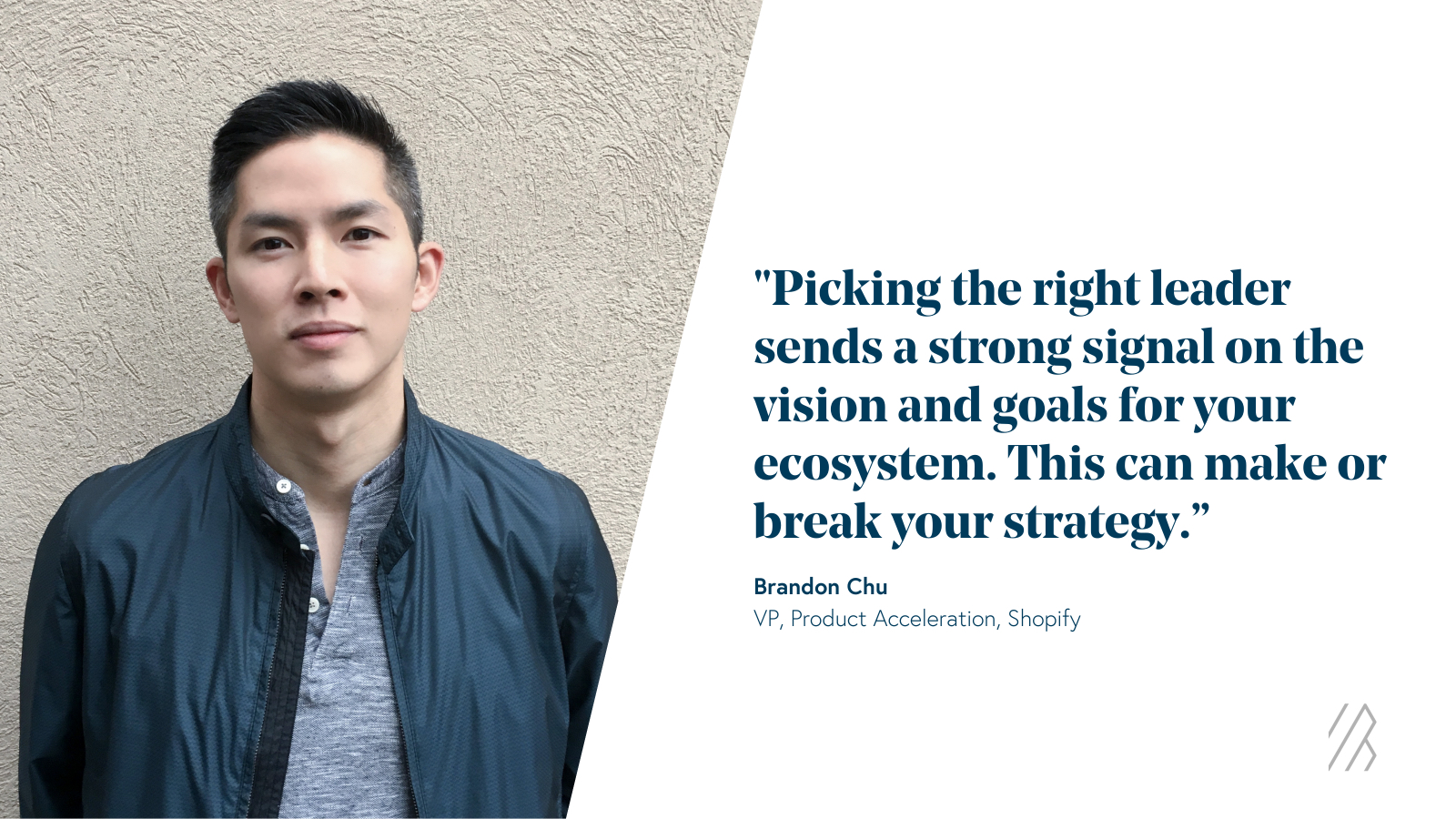
5. Foster and celebrate partner success
At Bessemer, we often say that “customer success is company success” in our 10 laws of Cloud. Similarly, when building out your ecosystem, partner success is paramount to ensuring ecosystem success. Applying the same strategies you would employ in a customer success playbook can translate well to guaranteeing partner success.
Shopify provided guides, webinars, and events for partners to make onboarding seamless and created a practical self-serve experience when launching its App Store. They also threw their resources behind partners to help them succeed. For example, they helped push and co-promote products from Bold Apps, one of their initial partners. Bold Apps started with four people working out of a basement; their first app was called Product Upsell, which allowed merchants to easily add targeted upsells to products. In less than a year and a half, the company increased its headcount by 10x, allowing the Bold team to build out a dozen more apps to benefit Shopify’s merchant community and strengthen the ecosystem.
As the adage goes, “success breeds success.” By supporting initial partnerships to help drive success, ecosystem creators can leverage these success stories as referenceable narratives to attract other partners and further fuel the flywheel.
Salesforce has been a stellar model of publicizing existing partners so that partner prospects can see the impact of a Salesforce partnership with tangible examples. Salesforce regularly spotlights partners on its AppExchange, one of the world's leading enterprise cloud ecosystems with over 5,000 solutions in the marketplace. It even provides specific recommendations for particular use cases through partner-specific user guides. Salesforce has also gone one step further, creating a bustling community through its Salesforce Partner Community program, allowing interaction and collaboration between partners through forums and events.
One Salesforce partner that has benefited from this philosophy of partner success is life sciences CRM provider Veeva. Since its inception in 2007, Veeva built its application natively on the Salesforce platform. Then the platform was promoted as Salesforce’s preferred and recommended provider of sales automation solutions for drugmakers in the pharmaceutical and biotechnology industry. Today, Salesforce references Veeva’s $40 billion market cap success story to explain why building natively on the Salesforce platform can lead to greatness.
Years later, Salesforce supported BVP-backed Vlocity as it developed industry-specific cloud and mobile software for sectors ranging from communications to media to energy. Like Veeva, Vlocity’s solutions were built natively on the Salesforce Platform, making it easy for Salesforce to support Vlocity’s market awareness in those verticals. Vlocity was Salesforce’s fastest-growing ISV out of 5,000 partners and was so successful that Salesforce acquired it in June 2020.
Highlighting the successes of past partners and marketing around them, primarily through your app ecosystem, is a strong lever that you can use to attract your future set of target partners.
6. Consider a development fund
As market leaders mature in developing their ecosystems, one strategy to ensure continued innovation is to create a corporate investment fund to attract new partners and support various ecosystem players.
Twilio adopted this strategy as early as 2011, years before its IPO, by setting up an initial microfund in conjunction with 500 Startups focused on supporting budding startups building on the Twilio platform. Beyond cash investment, this inaugural fund also provided Twilio credits and strategy advice to entrepreneurs.
At the first annual TwilioCon in 2011, startups competed for a chance to win seed capital investments from the initial Twilio Fund. Talkdesk, a startup that developed cloud-based call center software, won the contest. Less than ten years later, Talkdesk is currently valued at $10 billion. Today Twilio has matured its strategic investments even further, including setting up an in-house investment arm Twilio Ventures with a dedicated $50 million fund, and making multi-million dollar direct investments in companies such as Courier, Syniverse, and Algolia.
The development fund strategy can be incredibly effective in building out an ecosystem since it provides mutual buy-in from the start and encourages partnerships to be formed. This strategy is particularly effective in competitive markets, where collaboration with one ecosystem player is often formed at the expense of developing for another.
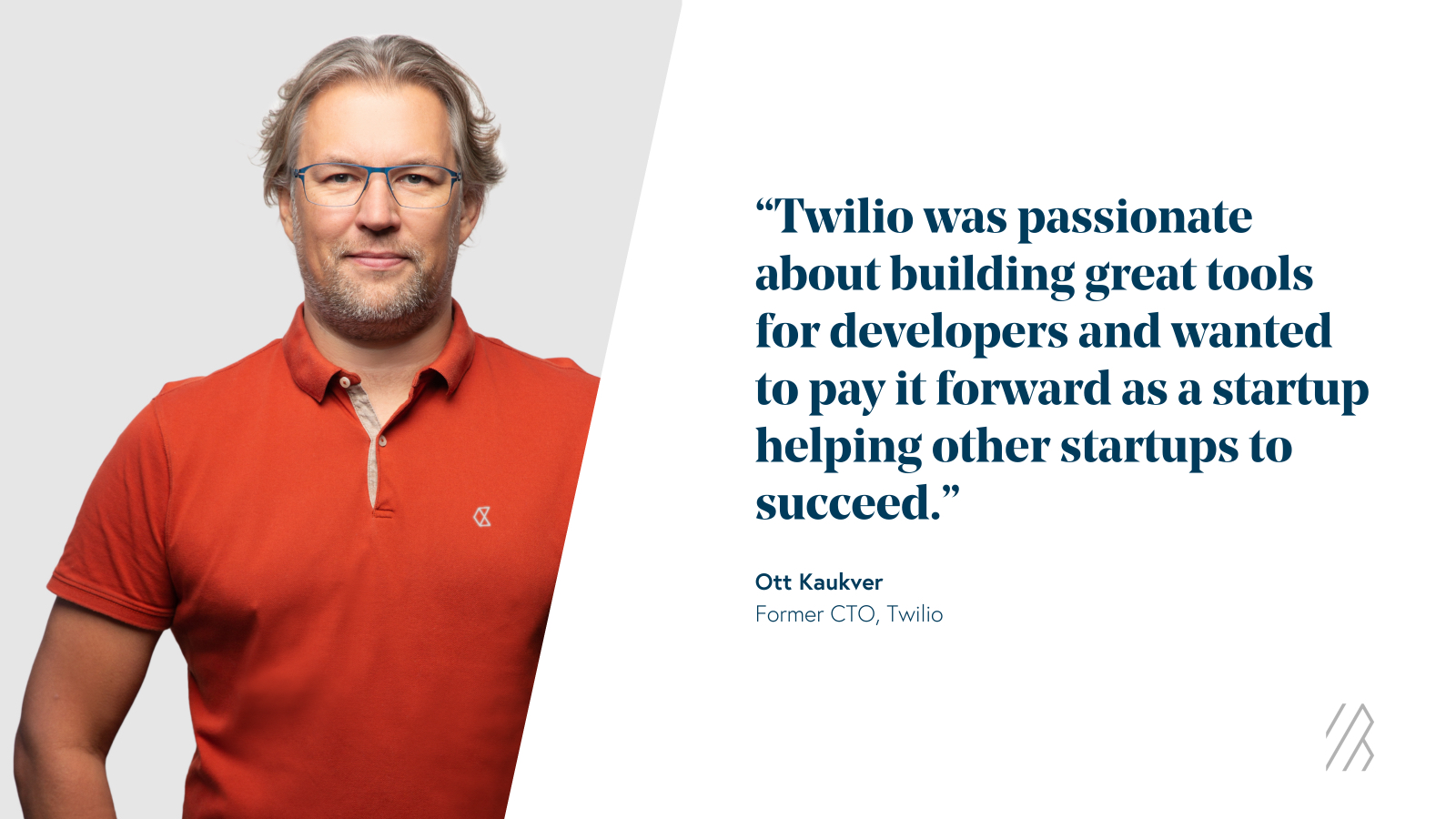
7. Iterate dynamically using metrics to guide actions
Ultimately, the process of building a strong ecosystem is never static. Just as products need development and fine tuning after launch, ecosystems also call for constant iteration to reinforce initiatives that are going well and to re-evaluate efforts that are falling short of their initial objectives. Iteration is also necessary since a company’s ecosystem goals are constantly evolving as an organization progresses through its lifecycle. Putting in place systems and workflows to set targets, track metrics, and measure success of different ecosystem efforts early on is crucial to this iterative process since data can be leveraged to guide decision-making.
DocuSign exemplifies how a business can leverage a data-driven approach to continually improve its partnerships strategy. The company regularly tracks core metrics related to its partnership efforts, including parameters such as integration key usage and qualified leads attributed to specific partnership programs.
Beyond tracking performance metrics, the company is proactive with quantitative insights; for example, they dedicate more resources to programs and initiatives that are improving the business goals of the ecosystem and also share important metrics with partners to strengthen relationships. These insights also go beyond the partnerships team to inform other aspects of the organization. For instance, the product team leverages these metrics to evaluate which parts of the product architecture should be outsourced via API and determine which integrations should be built in-house.
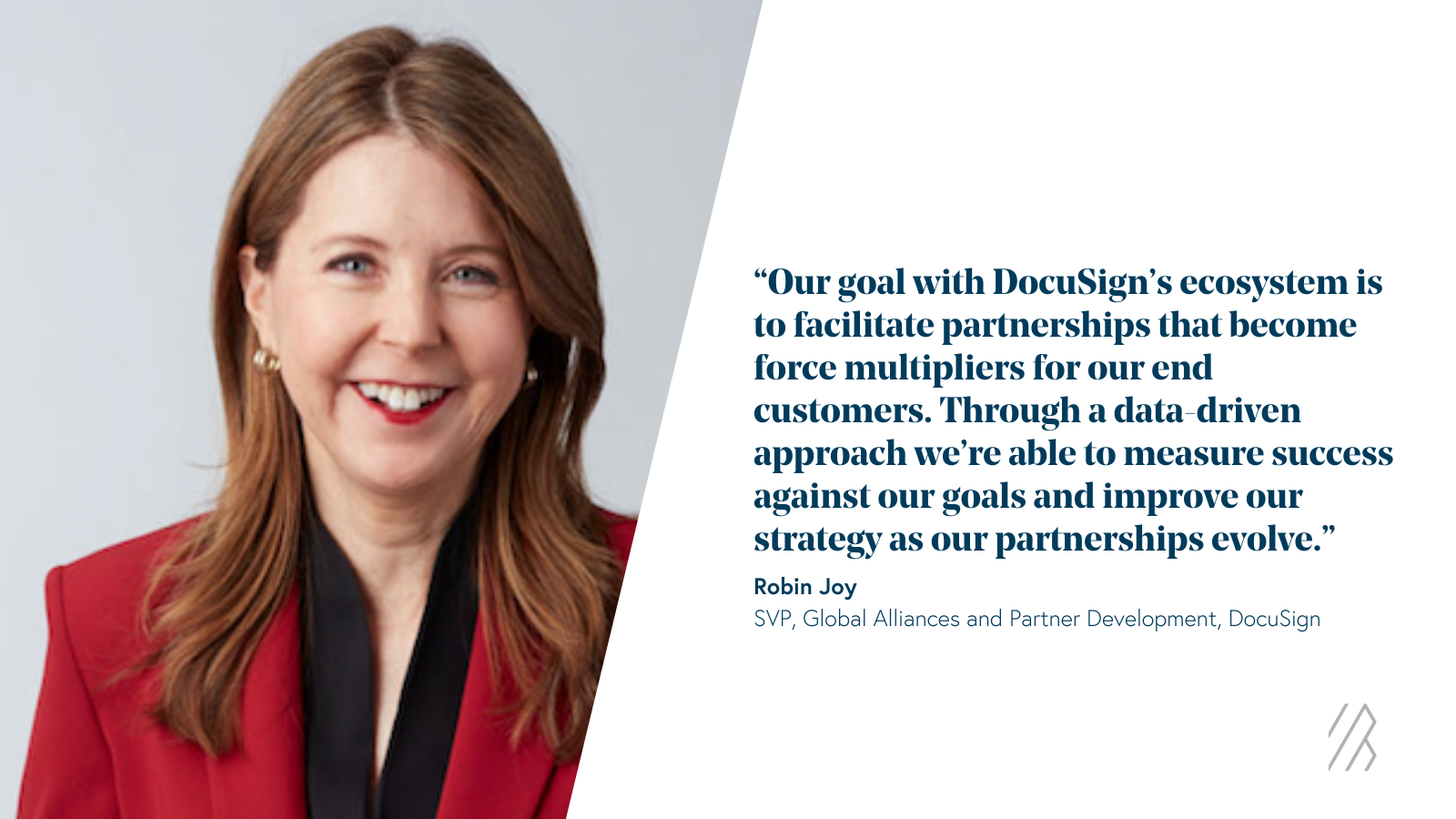
The most important part of an ecosystem play is taking the first step. Perfection is not required!
A fast-growing startup has many priorities, and it may seem daunting to channel resources to your unproven ecosystem play when first experimenting with this strategy. But as evidenced in the above success stories, the payoffs can be material for your enterprise as well as your partners’ path to scale.
When beginning your journey to build out an ecosystem, just remember that perfection is not required. Many of the cloud giants above began with only a handful of engineers working on ecosystem efforts in the early days to divert precious technical resources away from core priorities. Some even outsourced certain parts of the initiatives, such as partner support or specific integration builds, to reduce the burden on internal teams. Taking baby steps, not giant leaps is the ideal approach, and you can always pour in more resources once the flywheel is sparked!
Thank you to Robin Joy (DocuSign), Monty Gray (Okta), Stephen Lee (Okta), Brandon Chu (Shopify), and Ott Kauver (formerly Twilio) for sharing their insights.
If you would like to discuss any of the thoughts in this piece—or you lead a startup building a robust ecosystem—please contact Mary D’Onofrio on Twitter @mcadonofrio or Janelle Teng @NextBigTeng.





